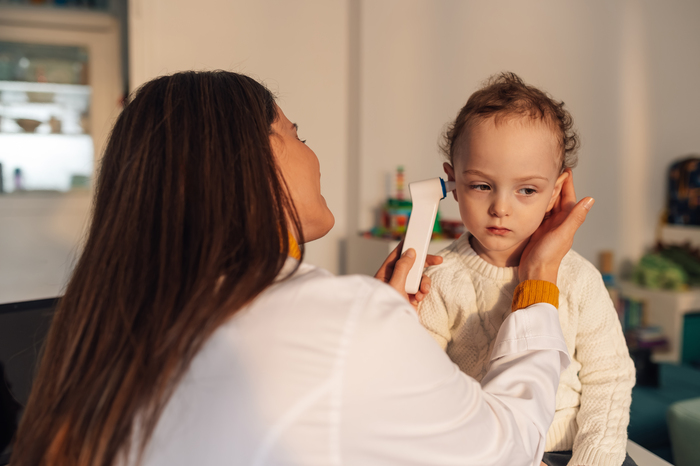
Feel better faster. Get care today.
From the clinic or your couch. Find high quality, same-day urgent care for you and your kids. Book an urgent care visit today.

Inner ear infections, commonly known as otitis media, but also medically known as labyrinthitis or vestibular neuritis, occur when the inner ear becomes inflamed due to infection, often leading to a range of uncomfortable symptoms. The CDC explains that this condition can affect balance, hearing, and overall well-being, making it essential to understand its signs and potential treatments. While inner ear infections can arise from various causes, including viral or bacterial infections, allergies, and even certain medical conditions, recognizing the symptoms early can lead to timely intervention and effective management.
An inner ear infection is an inflammation of the inner ear structures, primarily affecting the labyrinth, which is responsible for balance and hearing, according to the CDC. They explain that this condition can disrupt the normal functioning of the inner ear, leading to symptoms such as dizziness, vertigo, hearing loss, and balance issues.
There are two main types of inner ear infections: labyrinthitis and vestibular neuritis. Labyrinthitis involves inflammation of both the cochlea and the vestibular system, often resulting in both auditory and balance-related symptoms. In contrast, vestibular neuritis primarily affects the vestibular nerve, leading to significant balance disturbances without impacting hearing.

From the clinic or your couch. Find high quality, same-day urgent care for you and your kids. Book an urgent care visit today.
The symptoms of an inner ear infection in adults can vary in intensity and may include the following according to the CDC:
Vertigo – A sensation of spinning or dizziness that can be severe and debilitating.
Ringing in the ear (tinnitus) – A persistent noise in the ear, often described as a ringing, buzzing, or hissing sound.
Headaches – Frequent or intense headaches that may accompany other symptoms.
Earaches – Discomfort or pain in the ear, which can range from mild to severe.
Nausea – Feelings of sickness that may lead to vomiting, often triggered by balance issues.
Balance problems – Difficulty maintaining balance or a feeling of unsteadiness.
Hearing loss – A decrease in hearing ability, which may be temporary or permanent.
Sensitivity to sound – Increased sensitivity to loud noises or certain frequencies.
Fatigue – General tiredness or exhaustion, often resulting from the strain of coping with other symptoms.
The symptoms of an inner ear infection in children can manifest differently than in adults, according to the CDC. It is also important to note that an inner ear infection is not common in pediatrics. However, a list of common signs to look out for include:
Trouble sleeping – Difficulty falling or staying asleep, often due to discomfort or pain.
Constant crying – Increased fussiness or crying, which may indicate discomfort or distress.
Loss of balance – Difficulty maintaining balance or coordination, leading to frequent stumbling or falls.
Fever – Elevated body temperature, which can be a sign of infection.
Ear pain – Discomfort or pain in the ear, which can be persistent or intermittent.
Headache – Complaints of headaches, which may accompany other symptoms.
Irritability – Increased irritability or mood changes, often due to discomfort.
Loss of appetite – Decreased interest in eating or drinking, potentially due to pain or discomfort in the ear.
Treating an inner ear infection typically depends on the type of infection and its underlying cause, according to the CDC. For bacterial inner ear infections, doctors may prescribe antibiotics to eliminate the bacteria responsible for the infection. In cases where the infection is viral, antibiotics will not be effective, and treatment may focus on managing symptoms instead.
In addition to antibiotics, healthcare providers may recommend medications to help control nausea and vomiting, which are common symptoms associated with inner ear infections. Over-the-counter pain relievers can also be suggested to alleviate ear pain and discomfort. In some instances, physical therapy may be beneficial, especially if balance issues persist.
The CDC recommends that you seek professional medical care for inner ear infections if you experience any of the following signs:
Persistent symptoms – If symptoms such as dizziness, ear pain, or hearing loss continue for more than a few days without improvement, it's essential to consult a doctor.
Symptoms in a child less than 6 months old – Infants and young children with signs of an inner ear infection, such as fever or irritability, should be evaluated by a healthcare professional promptly.
Severe ear pain – Intense or worsening ear pain that is not relieved by over-the-counter pain medications warrants immediate medical attention.
High fever – A fever over 102°F (39°C) in conjunction with ear symptoms can indicate a more serious infection and should be assessed by a doctor.
Fluid drainage from the ear – If there is significant fluid or pus coming from the ear, especially if it is accompanied by other concerning symptoms, it's crucial to seek medical advice.
If you're experiencing symptoms of an inner ear infection or any other urgent health concern, don’t wait for relief—take action now! Use Solv to quickly find and connect with urgent care providers near you.
An inner ear infection, also known as otitis media, labyrinthitis or vestibular neuritis, is an inflammation of the inner ear structures, primarily affecting the labyrinth which is responsible for balance and hearing. It can be caused by various factors including viral or bacterial infections, allergies, and certain medical conditions.
Symptoms of an inner ear infection in adults can include vertigo, ringing in the ear, headaches, earaches, nausea, balance problems, hearing loss, sensitivity to sound, and fatigue.
In children, symptoms can manifest differently and may include trouble sleeping, constant crying, loss of balance, fever, fluid coming from the ear, ear pain, headache, irritability, and loss of appetite.
The treatment for an inner ear infection depends on the type and cause of the infection. For bacterial infections, doctors may prescribe antibiotics. If the infection is viral, treatment may focus on managing symptoms. Medications to control nausea and vomiting, over-the-counter pain relievers, and in some cases, physical therapy may be recommended.
Medical attention should be sought if symptoms such as dizziness, ear pain, or hearing loss persist for more than a few days without improvement, if symptoms are observed in a child less than 6 months old, if there is severe ear pain, a high fever over 102°F (39°C), or significant fluid or pus coming from the ear.